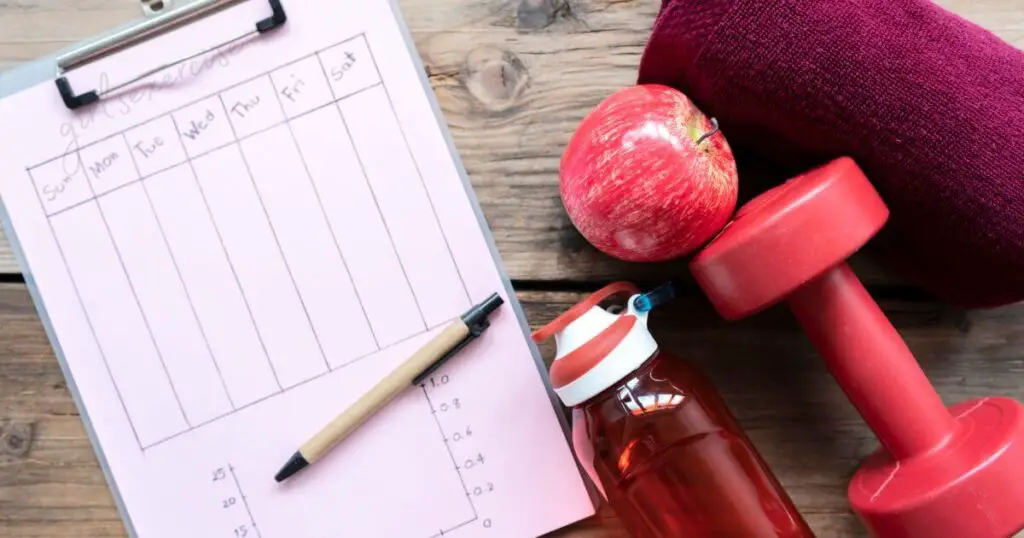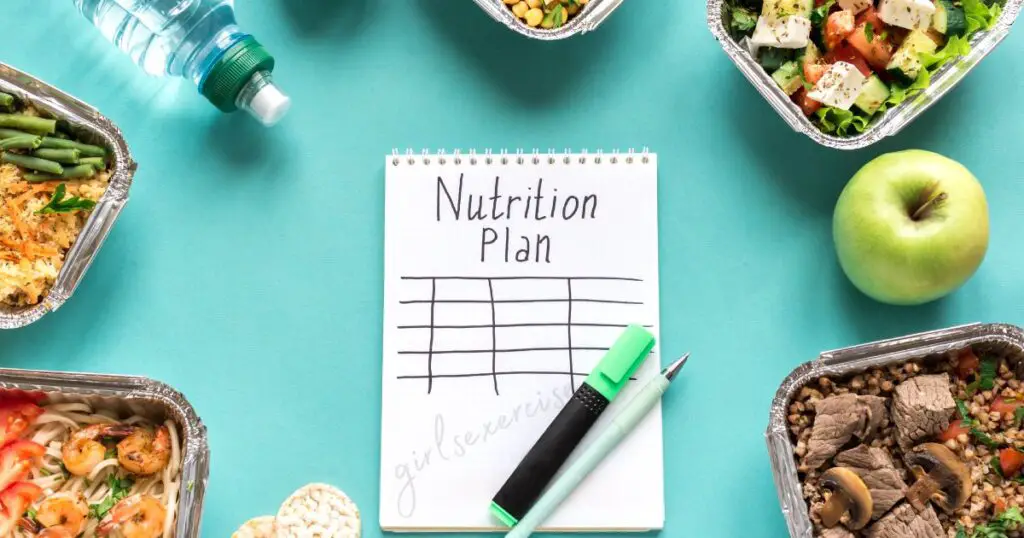Hello, lovely ladies! If you’re searching for an effective workout that can help you burn calories and achieve your body recomposition goals, you’ve come to the right place.
In this article, discover how incorporating targeted “Girl Exercise To Lose Weight” at the gym can accelerate fat loss and toning. We’ve curated a list of eight fantastic, women-focused fat-burning exercises to enhance your workout routine and achieve your fitness goals.
Is It Easy To Lose Weight For Females?
Typically, women may encounter more challenges when it comes to weight loss compared to men. However, this does not suggest that women cannot achieve success with a fat loss program.
Instead, it implies that women may experience a slower rate of fat loss, and these difficulties often arise from factors that are not within our immediate control.
Differences in Lean Muscle Mass:

Women often exhibit higher body fat percentages compared to men and tend to possess less lean muscle mass. Several factors contribute to this phenomenon.
Primarily, women have lower levels of testosterone, the hormone responsible for muscle growth and maintenance, with men having four to five times the testosterone levels that women do.
Women’s bodies tend to store more fat to support essential biological functions, such as childbearing and breastfeeding. Maintaining a higher body fat percentage is also crucial for regular menstrual cycles.
Hormonal Fluctuations:
Women experience more pronounced hormonal fluctuations, largely attributed to their menstrual cycle. Depending on the phase of their cycle, hormones can lead to increased hunger and fatigue, potentially causing higher calorie consumption.
Hormonal shifts during pregnancy and menopause can also influence women’s metabolism. Conditions like polycystic ovary syndrome (PCOS), affecting 5-20% of women of childbearing age, can introduce significant hormonal imbalances that pose challenges to weight loss.
Weightlifting Apprehension:
Many fitness centers often see a predominance of men in the weight room. While a few women do engage in weightlifting, most prefer group fitness classes or cardio equipment.
Although societal acceptance of women with muscular physiques has improved, some women still avoid weightlifting due to concerns about appearing bulky.
Nonetheless, weightlifting is essential for enhancing lean muscle mass, contributing to increased calorie expenditure throughout the day. Women who steer clear of strength training may miss out on the metabolism-boosting benefits associated with greater muscle mass.
Juggling Family and Professional Responsibilities:
Even when women receive support from their partners in childcare, they frequently find themselves taking on responsibilities like nighttime feedings, chauffeuring children to and from school or extracurricular activities, and meal preparation for the family.
Moreover, many women maintain full-time jobs alongside these domestic commitments. These multiple roles leave women with limited free time, often necessitating the sacrifice of their workouts and healthy eating habits to prioritize their family’s well-being and professional duties.
Emotional Eating Patterns:
While both men and women can engage in emotional eating, research indicates that women are more inclined to consume sugary, fatty, and carbohydrate-rich foods when dealing with stress, while men tend to experience reduced appetites in similar situations.
Hormonal fluctuations in women, as mentioned earlier, play a role in this tendency. Some studies have also suggested that women may possess a genetic trait affecting serotonin, the hormone responsible for mood stability and overall feelings of happiness.
Women with this genetic trait are more likely to engage in emotional eating, potentially leading to overconsumption.
The Problem With Most Female Fat Loss Workout Plans?

Before delving into my personal suggestions for designing a workout plan aimed at fat loss for women, I believe it’s essential to discuss some of the shortcomings associated with many online plans.
Identifying these issues will provide you with valuable insights and context for the recommendations I’ll be offering later in this article.
Limited Exercise Variety:
The workout program presented by Muscle & Strength maintains the same exercises, sets, and rep schemes for a continuous 10-week duration. Unfortunately, it lacks guidance on adapting sets and reps during a fat loss journey.
While the recommended exercises are generally effective, targeting major muscle groups and combining compound and isolation movements, the repetitive nature of this plan may lead to monotony.
Moreover, it doesn’t offer the opportunity to challenge your muscles in various ways or address specific areas that may require strengthening.
Absence of Rest Day Recommendations:
The workout plan by Muscle & Strength prescribes seven days of exercise per week, including three days for cardio or low-impact core work. This structure may inadvertently promote the misconception that more exercise is essential for weight loss.
For most women, daily training is unnecessary. Rest days can be better spent on activities
like stretching or achieving daily step goals without adding undue stress to the body. I outline ways to enhance physical activity without extra workouts later in this article.
A Quick 10-Minute Stretching Routine For Beginners
Insufficient Load Management Guidance:
The same plan from Muscle & Strength lacks information on proper weight selection for each exercise, as well as recommendations for progressively increasing weights each week.
Understanding the challenges of catering to a diverse readership, it is possible to provide general weight selection guidelines to help individuals begin. I will share my own suggestions for weight selection later in this article.
Unrealistic Weight Recommendations:
Worse than offering no weight selection guidance is suggesting weights that do not align with practicality. For instance, a workout program in Muscle and Fitness Hers advises using a 3lb ankle weight for a glute exercise.
Three pounds is typically insufficient for most healthy women to effectively build muscle. This weight is lighter than everyday items carried regularly.
Newborns born at full-term often weigh more than 3 lbs. It’s highly likely that your everyday purse or work tote bag is heavier than this. Achieving strength gains necessitates lifting weights heavier than the groceries or toddlers you handle daily.
Unsustainable Dietary Plans:
Diet culture and so-called “health experts” sometimes exploit women’s insecurities by promoting calorie-restrictive diets. Women’s Health magazine presents a diet plan claiming to be the “best diet plan for weight loss ever,” which can be problematic.
This diet plan assumes that any woman seeking weight loss should consume only 1,500 calories per day. Even for non-professional athletes, this caloric intake falls short of supporting an active lifestyle. To illustrate, 1,500 calories daily is the recommended amount for a 7-year-old girl.
Expecting adult women, particularly those who lead physically active lives, to sustain themselves on 1,500 calories daily is unreasonable. Most women expend more calories simply by going about their daily activities.
Such diet plans presume that all women require identical proportions of protein, carbs, and fats daily, disregarding activity levels, current weight, and individual lifestyles.
The plans lack guidance on personalizing the diet to meet individual needs, except for suggesting a post-workout snack for those who frequent the gym.
Factors To Consider When Designing A Female Fat Loss Workout Plan?

Considering the inaccuracies and logical inconsistencies often found in many women’s fat loss programs, let’s explore the correct approach to designing a fat loss workout plan tailored for women.
Exercise Selection: Crafting an effective fat-loss workout plan for women necessitates a balanced blend of compound and isolation exercises. Compound exercises like squats and bench presses play a crucial role in preserving or even gaining strength during calorie deficit phases.
Their significance lies in recruiting multiple muscle groups with each repetition, thereby promoting calorie burn. Conversely, isolation exercises cater to smaller muscle groups such as calves and biceps, ensuring their retention during the fat loss journey.
Periodically altering exercises every 4-6 weeks infuse novelty and counters monotony. While fundamental exercises like squats, deadlifts, and bench presses should remain constant, incorporating variations like pause squats or Romanian deadlifts can keep the routine engaging and target muscles differently.
Training Volume: Managing training volume is pivotal when operating on reduced calorie intake. To safeguard lean muscle mass, it’s advisable to adhere to rep ranges of 5-10 or 10-15, depending on the exercise.
Compound movements, such as squats or deadlifts, are ideally performed with lower reps, while isolation exercises, like calf raises or triceps extensions, can benefit from higher reps.
Should calorie restrictions impede your ability to complete prescribed sets or reps, consider halving them. For instance, if your program dictates 4 sets of back squats, reducing it to 2 sets is a practical adjustment.
Moreover, energy levels may fluctuate day to day, permitting alterations in sets and reps based on your perceived capacity.
Training Intensity:
As your fat loss journey progresses, energy levels may fluctuate significantly. Initiating a cut may not drastically affect your workout intensity initially, but as caloric intake decreases, maintaining high-intensity workouts can become challenging.
It may be practical to maintain an intensity of around 70-75% of your one-rep max (1RM) during the final weeks of your fat loss phase. Careful self-assessment will be required to adapt daily training intensity according to your physical state and perceived capacity.
Training Frequency:
Sustaining a training frequency of 4-5 days per week is beneficial for mitigating muscle loss during a fat-loss phase. However, caloric limitations and reduced energy levels may necessitate the adjustment of your training schedule.
It may become imperative to reduce the number of workouts per week. Even with just two training sessions weekly, you can still maintain strength, although you may experience temporary weakness until your fat loss phase concludes and caloric intake increases.
Load Management:
Whether you are a seasoned lifter or a novice, selecting the appropriate weights for your exercises is crucial. Newcomers to strength training can experiment by commencing with an empty barbell or lightweight dumbbells, and completing 10-12 reps of an exercise.
The ability to complete reps comfortably while maintaining proper form indicates readiness to increase the weight. On the other hand, the inability to complete reps signifies a need for weight reduction.
It’s also essential to avoid lifting to failure and conclude each set with the feeling of 2-3 reps left in the tank. This systematic approach ensures that the weight aligns with your capabilities, fostering progress while reducing the risk of injury.
Weight Progressions:
Progression in weight management, especially in calorie-restricted phases, may eventually reach a plateau. A beneficial alternative is Rate of Perceived Exertion (RPE) training, which evaluates the difficulty of each lift on a scale of 1-10, with 1 being effortless and 10 signifying maximal effort.
RPE training accommodates your fluctuating energy levels and removes the pressure of consistently adding weight to your lifts. When your RPE shifts, your weight selection can be adapted to match your perceived exertion, ensuring effective training while managing fatigue.
Recovery:
Effective recovery is paramount during a fat loss phase. Lower calorie intake can lead to heightened soreness and increased exercise difficulty. Adequate sleep, around 7-8 hours per night, plays a pivotal role in managing fatigue levels.
Staying well-hydrated, with at least 75 ounces of water daily, can help prevent muscle soreness. Incorporating 2-3 rest days and a deltoid week every 4-6 weeks offers respite for the body and mind, fostering recovery.
Daily stretching for 15-20 minutes and gentle active recovery, like walking or light cycling, can alleviate muscle soreness without introducing excessive intensity that might prolong recovery.
Do You Need To Do Cardio On A Fat Loss Workout Plan?
Cardio vs. Diet: Achieving fat loss doesn’t necessitate endless hours on the treadmill if you’re maintaining a true calorie deficit and emphasizing a balanced diet rich in lean proteins, healthy fats, and nutrient-dense carbohydrates with each meal.
While cardio holds significant benefits for heart health, it doesn’t have to dominate your routine. Committing to just three weekly sessions of moderate-intensity cardio, each lasting 30 minutes, can suffice to enhance your fat loss journey.
This approach offers a more balanced and sustainable way to achieve your goals, sparing you from the potential monotony of excessive cardio.
Non-Exercise Activity Thermogenesis (NEAT):
Beyond cardio, there’s a subtler yet equally effective approach to calorie expenditure – Non-Exercise Activity Thermogenesis (NEAT). NEAT encompasses the physical activities performed outside of the gym, typically excluded from the realm of structured exercise.
Everyday tasks such as house cleaning, gardening, choosing the stairs over the elevator at work, embracing a standing desk, and engaging more frequently in playful activities with your children contribute to your NEAT levels.
Elevating your NEAT not only bolsters calorie burning but also promotes a more active and dynamic lifestyle. By embracing these everyday opportunities for movement, you can seamlessly enhance your overall energy expenditure.
making a meaningful impact on your fat loss journey without feeling tied to a traditional cardio regimen. This approach not only helps you achieve your desired physique but also fosters holistic well-being through a balanced and enjoyable daily routine.
Female Fat Loss Workout Plan?

Embarking on a journey towards fat loss, it’s essential to embrace a workout plan that aligns with your goals, ensuring sustainable progress. This 5-day workout plan strikes a balance between strength training and cardio, with a designated day for active recovery and a vital rest day. The focus here is on gradual and consistent progress, promoting both physical and mental well-being.
Day 1 – Lower Body and Core
Back squats: Initiate with 3 sets of 6 reps.
Hip thrusts: Continue with 3 sets of 8 reps.
Bulgarian split squat: Challenge yourself with 4 sets of 8-10 reps per leg.
Lying hamstring curl: Further, target the lower body with 4 sets of 10-12 reps.
Seated calf raises: Strengthen your calf muscles with 4 sets of 12-15 reps.
Planks: Enhance core stability with 3 sets lasting 60 seconds each.
Day 2 – Upper Body
Bench press: Begin with 3 sets of 6 reps.
Pendlay row: Progress to 3 sets of 8 reps.
Seated dumbbell press: Focus on 3 sets of 8-10 reps.
Pull-ups: Challenge your upper body with 4 sets of 8-10 reps.
Bicep curls: Isolate the biceps with 4 sets of 12-15 reps.
Skull crushers: Engage the triceps with 4 sets of 12-15 reps.
Day 3 – Rest or Active Recovery
Use this day for recovery, with options including 30 minutes of moderate-intensity cardio, mobility work, or achieving 8,000 – 10,000 steps.
Day 4 – Lower Body and Core:
Deadlifts: Commence with 3 sets of 6 reps.
Walking lunges: Progress with 3 sets of 8-10 reps per leg.
Good mornings: Strengthen the lower body with 4 sets of 8-10 reps.
Standing calf raises: Target the calves with 4 sets of 12-15 reps.
Ab wheel rollouts: Enhance core strength with 3 sets of 8-10 reps.
Day 5 – Upper Body:
Overhead press: Embark with 3 sets of 6-8 reps.
Incline DB bench press: Continue with 3 sets of 8-10 reps.
Lateral raises: Focus on 3 sets of 8-10 reps.
Hammer curls: Isolate the biceps with 4 sets of 12-15 reps.
Tricep extensions: Engage the triceps with 4 sets of 12-15 reps.
Day 6 – Moderate-Intensity Cardio:
Dedicate a maximum of 30 minutes to moderate-intensity cardio activities like jogging, using the elliptical machine, rowing, or enjoying a leisurely hike.
Day 7 – Rest Day:
Allow yourself a complete day of rest. While mobility work and achieving your daily steps are encouraged, refrain from overexerting yourself through strenuous exercise.
To optimize your fat loss journey, aim for consistent training over 12-16 weeks, incorporating a deload week during this period.
Choose a workout plan that aligns with your goals and adjusts according to your recovery and performance. For personalized guidance, consider using the Fibbed app, which offers tailored workout plans and tracking your progress. Get started with Fitbit today and enjoy three free workouts.
How Much Fat Can You Expect To Lose?
Embarking on a fat loss journey involves understanding that the rate and extent of your progress are influenced by a multitude of factors. It’s a personalized and evolving process, shaped by your unique starting point and the choices you make along the way.
Initial Body Fat Percentage:
Your starting point plays a pivotal role. If you’re commencing your journey with a higher body fat percentage, your results may tend towards the higher end of the spectrum. Conversely, if you’re already relatively lean, your progress may lean toward the lower end of the scale.
Training Regimen:
The type of training you engage in significantly impacts your fat loss outcomes. A well-structured workout plan that balances strength training and cardiovascular exercise can expedite fat loss while preserving muscle mass.
Dietary Choices:
What you eat, how you eat, and the extent to which you monitor your calorie intake all impact your fat-loss journey. Sustainable calorie reduction, coupled with a balanced macronutrient profile, ensures gradual and effective progress.
Stress Levels:
Managing stress is essential, as elevated stress levels can hinder your fat loss efforts. Incorporating stress-reduction techniques such as meditation, yoga, or mindfulness can be beneficial.
Genetics:
Genetic factors can influence how your body responds to fat loss. While genetics are beyond your control, understanding that your journey is unique to you can help manage expectations.
Non-Exercise Activity:
Daily activities outside the gym, known as Non-Exercise Activity Thermogenesis (NEAT), also contribute to your fat loss. Incorporating more movement into your daily life, such as walking or using the stairs, can complement your efforts.
Weight Loss on the Scale:
A sustainable rate of weight loss on the scale is approximately 0.5-1 pound per week. This approach ensures that you don’t need to excessively restrict calories and helps preserve precious muscle mass.
Body Fat Percentage:
Measuring body fat percentage is challenging, but it’s a valuable metric to monitor. While methods like DEXA or hydrostatic weighing are precise, a realistic goal is to lose 1-3% of body fat per month. This range accommodates variations based on your initial body fat percentage, offering a balanced perspective on achievable outcomes.
Individualized Journey:
Recognizing that your journey is unique and multifaceted can empower you to make informed decisions and manage your expectations effectively. Embrace the progress you make, knowing that every step is a positive stride towards your goals.
Diet Considerations For A Female Fat Loss Plan?

Embarking on a fat loss journey necessitates a fundamental grasp of caloric principles. To successfully shed excess body fat, you must create a calorie deficit—consuming fewer calories than your body expends.
However, rushing headlong into a calorie-cutting regime is ill-advised. Prior to initiating your fat loss plan, it is crucial to ascertain your maintenance calories.
These represent the daily caloric intake that sustains your current body weight. It is especially pertinent for women, who often unknowingly underheat.
By accurately determining your maintenance calories, you may discover that you can maintain your current weight while consuming more calories than previously assumed.
This revelation will enable you to commence your calorie deficit at a more generous daily intake, rendering your fat loss journey more sustainable.
Several methods can be employed to pinpoint your maintenance calories:
Online Calculators:
Various online tools, such as Total Daily Energy Expenditure (TDEE) calculators, provide estimations based on your activity level and personal data.
Nutrition Calculators:
Utilize comprehensive nutrition calculators like Precision Nutrition’s macro calculator to establish your daily caloric needs.
Caloric Tracking:
Consistently monitor your dietary intake for 1-2 weeks via apps like MyFitnessPal to gauge your current consumption. If you discern the potential for an increase, gradually augment your daily calories by 100-200 weekly over 2-3 weeks, all while closely monitoring weight changes.
If these incremental adjustments don’t result in weight gain, it signifies that you were inadvertently depriving yourself previously.
Taking this preliminary step to accurately gauge your maintenance calories will serve as a strong foundation for your subsequent fat loss efforts, ensuring a balanced and sustainable approach to achieving your desired results.
How To Determine Your Macro Breakdown For A Fat Loss Phase?
Once you’ve determined your maintenance calorie threshold—the amount you can consume without weight gain—it’s time to tailor your daily calorie intake to establish a calorie deficit. A prudent approach is to commence with a gradual reduction of 200-300 calories per day.
However, while overall calorie intake holds paramount significance, the distribution of macronutrients throughout the day can significantly impact the effectiveness of your fat-loss journey.
Macronutrients, often referred to as macros, encompass the three key nutritional
components in your diet: protein, fat, and carbohydrates. Maintaining an appropriate balance of these macros during your fat loss phase is vital as they provide energy for your workouts, prolong satiety, and promote post-exercise recovery.
Given that each individual is unique, you may need to experiment with varying macro compositions to identify the most favorable combination for your well-being during the fat loss process. Nonetheless, consider the following guidelines as an initial reference:
Protein:
Adequate protein intake is indispensable during a fat loss regimen, as it safeguards your existing lean muscle mass. Aim for a minimum of 0.8 grams of protein per pound of body weight daily. For instance, if you weigh 160 pounds, your target should be at least 128 grams of protein.
Carbohydrates:
Despite the unwarranted demonization, carbohydrates are crucial for active women to fuel workouts and support recovery. Carbohydrates may constitute 40-50% of your total daily caloric intake, contingent on your activity level.
A more sedentary lifestyle warrants a lower range while engaging in extended weightlifting and physical labor calls for the upper range. As an illustrative example, if your daily target is 2,000 calories with 40% allocated to carbs, it amounts to 800 carb-derived calories, equivalent to 200 grams, as each gram of carbohydrates provides 4 calories.
Fats:
Adequate dietary fat intake plays a pivotal role in maintaining hormonal balance. Fats should contribute to at least 25% of your daily caloric intake. Applying the same 2,000-calorie scenario, around 400 calories should be derived from fat sources, translating to approximately 55-56 grams of fat per day, as each gram of fat supplies 9 calories.
Customizing your calorie and macronutrient distribution in accordance with your needs and preferences will empower your fat loss journey, ensuring a balanced and sustainable approach to attaining your desired results.
How Do You Know When To Decrease Calories Further?
Throughout your fat loss phase, diligent tracking of your progress is a valuable practice to help you navigate the road to success.
A prudent approach involves weighing yourself on a minimum of three days per week and then calculating the weekly average weight. This average weight serves as a reliable indicator to determine whether caloric adjustments are necessary.
It’s important to understand that your daily weight may exhibit minor fluctuations. Various factors, such as your previous day’s dietary intake, quality of sleep, and the nature of your preceding workout, can lead to slight fluctuations on the scale.
Your menstrual cycle plays a significant role, with PMS-related bloating and water retention causing temporary increases in weight. Relying solely on a single weigh-in right before your period may result in unwarranted caloric reductions.
As a sound practice, refrain from implementing substantial dietary changes for at least two weeks. It’s not uncommon for weight to plateau for several weeks during a fat-loss phase, only to experience a sudden drop afterward.
This ebb and flow is part of the journey, and patience is key. Hastily slashing your calorie intake can render your diet challenging to sustain, increasing the likelihood of succumbing to cravings or fatigue-induced workout skips.
An essential point to remember is that when reducing calories, maintain consistent protein levels and initially trim calories from carbohydrates or fats. This safeguards against the risk of excessive muscle loss, preserving your hard-earned progress.
How Long Should You Stay In A Calorie Deficit?

Completion of a fat loss phase is often recommended after approximately 12-16 weeks. This suggestion arises from a consideration of the stress that a caloric deficit imposes on your body, especially when combined with your daily routines and exercise regimen.
Over an extended period, this cumulative stress might become challenging for your body to manage effectively. Once the recommended timeframe has passed, the transition from a caloric deficit should occur gradually. You can begin by incrementally increasing your daily calorie intake.
A conservative approach involves adding 100-200 calories per day each week. This incremental adjustment allows you to identify your new maintenance caloric level without experiencing unwanted weight gain.
It’s important to note that if your caloric deficit is not overly aggressive, your energy levels remain satisfactory, and your workouts maintain their effectiveness, you can contemplate extending the duration of your fat loss phase.
Should you choose to prolong your calorie deficit phase, consider implementing one-week diet breaks every 6-8 weeks. These brief periods involve temporary calorie increases, providing your body with some respite from the ongoing stress of maintaining a caloric deficit.
It’s crucial to maintain nutritious food choices and adhere to your exercise routine during these breaks to ensure that your progress is not compromised. These strategic diet breaks can promote sustainability, helping you maintain a healthy relationship with your body and your long-term fitness goals.
What Supplements Should Females Take During A Fat Loss Phase?

In a world brimming with social media fitness influencers, nutrition stores, and endorsements from professional athletes, the idea of needing a multitude of supplements to facilitate fat loss can often be misleading.
In reality, the essential supplements to consider during your fat loss journey are relatively straightforward and manageable.
Caffeine:
A fundamental inclusion in your fat loss program, caffeine can play a pivotal role in providing you with the necessary energy to conquer your workout sessions.
Whether you prefer coffee or opt for a prelockout supplement before hitting the gym, the timing of caffeine consumption is crucial for its optimal impact on your training. Aim to consume caffeine approximately 40-60 minutes before your workout session to harness its full potential.
It’s important to be mindful of caffeine dosage, as excessive intake may lead to sleep disturbances, jitteriness, or an unwanted increase in heart rate and blood pressure.
Keep in mind that the recommended dosage is typically listed on reworkout supplement labels. For those sensitive to caffeine, a lesser quantity may be more suitable.
Protein Powder:
Active women, especially those engaging in weightlifting, often require higher protein intake. While it can be challenging to meet these elevated protein needs through dietary sources alone, protein powder comes to the rescue.
Offering a convenient source of protein, most protein powders deliver 20-30g of protein per serving. Whey protein is a common choice, but plant-based or non-dairy alternatives are available for those with dietary restrictions.
It is essential to remember that protein powder should not serve as a complete meal replacement. Although it can be a handy solution for on-the-go breakfasts, whole food sources should remain the primary protein source.
Creatine:
Backed by substantial research, creatine stands as one of the most well-documented supplements. Studies consistently demonstrate its ability to enhance strength, boost muscle mass, and improve power output during high-intensity exercises.
Creatine is an amino acid naturally occurring in muscle cells and is also present in protein-rich foods like red meat and seafood. To reach the recommended daily intake of 5g of creatine, significant dietary consumption is necessary.
While creatine is highly effective when taken post-workout, it can be incorporated into your daily routine at any time.
In closing, many women’s fat loss plans often lack the clarity and comprehensive guidance needed for exercise selection, load management, training intensity and frequency, and dietary choices. To achieve the most favorable results, structuring your workout plan and dietary intake appropriately is essential.
Prioritize weightlifting, maintain a caloric deficit, and incorporate 2-3 days of 30-minute cardio sessions for optimal progress. Emphasizing protein consumption, and elevating your non-exercise activity thermogenesis (NEAT) throughout the day can significantly accelerate your fat loss journey.
A strategic and balanced approach to supplements can enhance your overall experience during this transformative phase.
Conclusion:
Exercise plays a pivotal role in a girl’s weight loss journey, but it should be complemented by a well-balanced diet. There are no shortcuts to losing weight. It’s essential to stay dedicated, patient, and consistent in your efforts, as results may take time to become evident.
Whether you choose to work out at the gym, at home, or outdoors, remember that the most effective exercise routine is one you enjoy and can maintain in the long run. Combine a variety of cardiovascular and strength training exercises, and make dietary choices that support your weight loss goals to achieve the best results.
FAQs About Girl Exercise To Lose Weight
What are some effective exercises for girls looking to lose weight?
Effective exercises for weight loss include a combination of cardiovascular activities like running, cycling, and swimming, alongside strength training exercises like squats, lunges, and push-ups. These help burn calories, increase metabolism, and build muscle.
How many days a week should girls exercise for weight loss?
Aim for at least 5 days a week of exercise to lose weight. A mix of cardio and strength training is ideal. It’s essential to allow your body time to recover, so ensure you have 1-2 rest days in your weekly routine.
Can girls lose weight by only doing ab exercises?
While ab exercises like crunches and planks can strengthen your core, they won’t lead to significant weight loss. Targeting specific body areas for fat loss (spot reduction) is a myth. A balanced workout routine that involves whole-body movements is more effective.
Are there specific workouts better suited for girls in their weight loss journey?
Girls can benefit from a variety of workouts, and the choice depends on individual preferences and fitness levels. High-intensity interval training (HIIT), dance classes, and group workouts can be enjoyable options. Remember to choose exercises that you enjoy to stay motivated.
What’s the role of diet in a girl’s weight loss exercise plan?
Diet plays a critical role in weight loss. Combine exercise with a balanced, calorie-controlled diet that includes plenty of fruits, vegetables, lean proteins, and whole grains. This synergy between diet and exercise yields the best results.
Can girls lose weight without going to the gym?
Absolutely. While the gym offers a variety of equipment and classes, weight loss doesn’t require a gym membership. You can exercise at home or outdoors with bodyweight workouts, running, and cycling. Consistency is key, regardless of the workout location.
How long does it take for girls to see results from their exercise routine for weight loss?
The rate of progress varies from person to person. Generally, visible results may take a few weeks to a few months. Remember, it’s not just about the destination but the journey. Consistency and a sustainable routine are vital for long-term success in weight loss.



